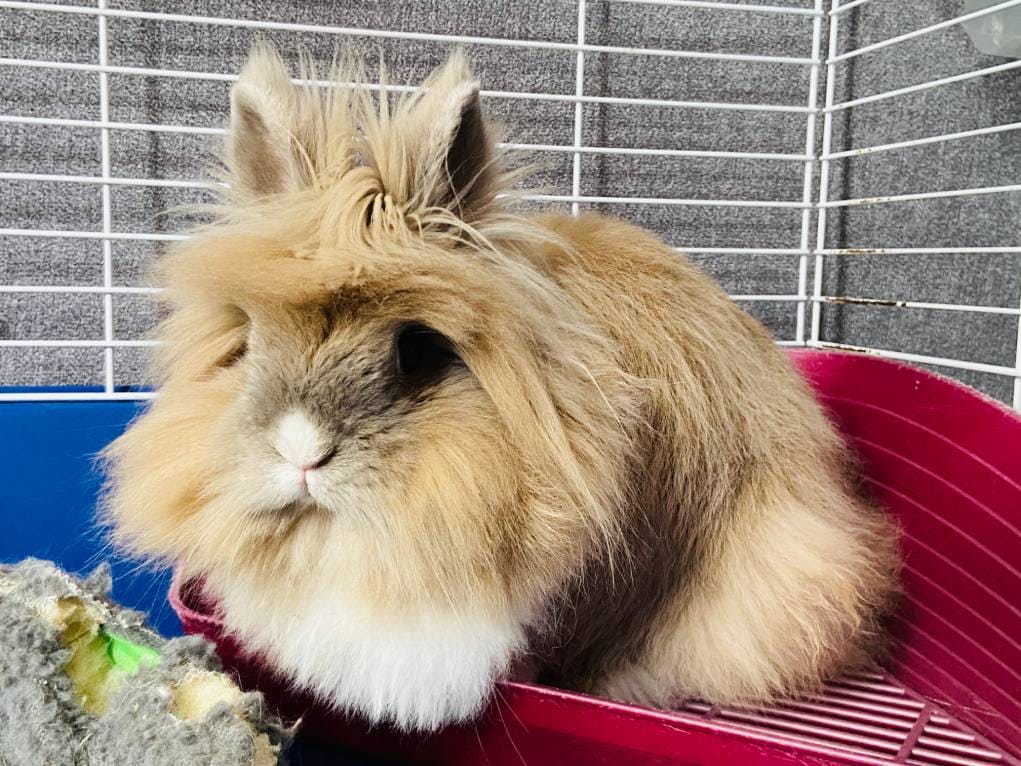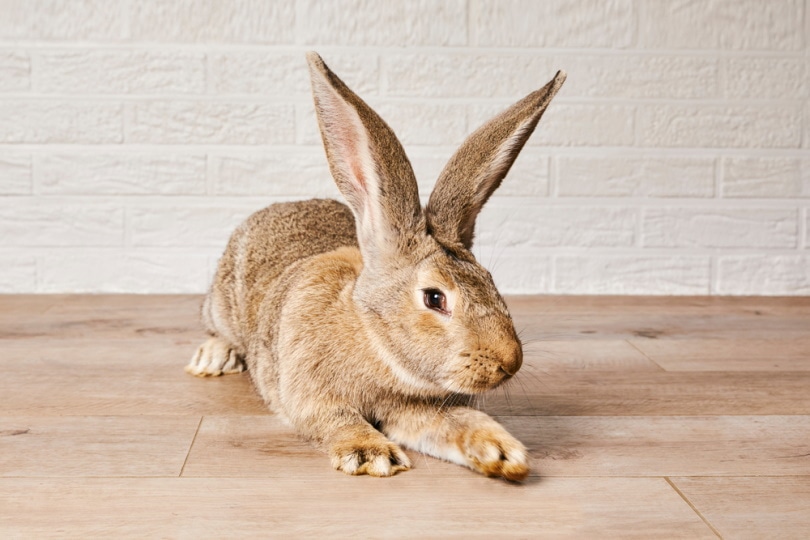
Click to Skip Ahead
Welcome to the fascinating world of Florida White Rabbits! These adorable bunnies showcase a mix of traits from the breeds they originate from, capturing the spunkiness of the Dutch, the friendliness of the Holland Lop, and the adaptability of the Netherland Dwarf and Jersey Wooly.
Their pure white coat and ruby-red eyes are some distinguishing features that rabbit enthusiasts fall in love with. But that’s not all. Read on to learn all about the Florida White Rabbit and find out if it’s the pet for you.
| Size: | Miniature |
| Weight: | 4–6 pounds |
| Lifespan: | 5–8 years |
| Similar Breeds: | Polish, Dutch, New Zealand |
| Suitable For: | Families with allergies, anyone looking for a loving companion |
| Temperament: | Docile, friendly, stubborn but good-natured |
Florida White Rabbits are known for pushing back against socialization training. But if you can get past their somewhat stubborn attitude in this regard, you’ll find a well-behaved, relaxed critter that enjoys your company and trusts you.
Florida White Rabbit Characteristics
How Much Do These Rabbits Cost?

Florida White Rabbits are a breed native to the United States. They were originally bred in the 1960s in Florida, primarily for laboratory use due to their small size and manageable care needs. However, their lovable personality and striking appearance quickly made them popular as pets.
Due to their rich history and relative rarity, Florida Whites tend to be pricier than some other rabbit breeds. Prices may vary but expect to pay upwards of $100 for a Florida White Rabbit from a reputable breeder.
Temperament & Intelligence of the Florida White Rabbit
Florida White Rabbits are known for their friendly and adaptable temperament. They are intelligent creatures who can be trained with a little patience and positive reinforcement. Their spunky personality keeps their owners entertained, and their sociable nature means they enjoy the company of humans and other rabbits alike.
Do These Rabbits Make Good Pets?
The small size and docile nature of Florida Whites make them manageable pets, and their sociability makes them enjoyable companions. They can adapt well to different environments, and their intelligence makes them fun to interact with.
Please note, though, that like all rabbits, Florida Whites require committed, responsible owners who can cater to their specific care needs. You’ll likely need patience if your Florida White struggles to socialize—whether with strangers, other pets, or even with you!
This breed can have a challenging time getting acclimated to new things. But if you employ sociability training with love and patience, you’ll discover a loving rabbit friend who appreciates your protection and companionship.
Does This Rabbit Get Along With Other Pets?
As long as you take the time to get them used to others, yes, they will get along with other pets. Florida White Rabbits are sociable once they get used to their new surroundings and can get along with other pets and rabbits quite well. They can also coexist with calm and non-predatory house pets, like a gentle dog or cat, under careful supervision.
It’s always important to ensure any introductions to other pets are done gradually and under controlled conditions to ensure the safety and comfort of all animals involved.
Things to Know When Owning a Florida White Rabbit
Food & Diet Requirements 🥕
Florida White Rabbits thrive on a balanced diet consisting primarily of high-quality hay, such as Timothy hay. Hay is an essential component of a rabbit’s diet as it provides the necessary fiber for their digestive health and also helps to wear down their teeth, preventing overgrowth.
In addition to hay, a small quantity of fortified rabbit pellets can be given daily for added nutrition. Fresh vegetables like carrots, bell peppers, and leafy greens should also be included in their diet but introduced slowly to avoid upsetting their sensitive stomachs.
Fruits can be offered as an occasional treat due to their high sugar content. It’s also crucial to ensure that your rabbit has constant access to clean, fresh water to stay properly hydrated.
Habitat & Hutch Requirements 🏠
Despite their miniature stature, Florida White Rabbits need ample space to hop, play, and express natural behaviors. Their indoor cage or hutch should be spacious, ideally five times their size when fully stretched out.
A cage with a solid floor is best to avoid harming their sensitive feet, and it should be lined with soft bedding such as straw or recycled paper. The hutch should also have a hideaway section where the rabbit can retreat to feel secure.
And if it’s feasible, Florida Whites will appreciate a safe, enclosed outdoor area where they can explore, frolic, and graze, given that the weather is favorable and they are always supervised.
Exercise & Sleeping Needs 🐇
Being active creatures, Florida Whites require regular daily exercise to maintain their health and well-being. A secure, rabbit-proofed area, either indoors or outdoors, is necessary where they can hop and play freely.
They love toys, especially ones they can chew on, like untreated wood blocks, cardboard tubes, or willow balls. Providing these toys not only keeps them entertained but also promotes dental health by helping to wear down their continuously growing teeth.
Like most rabbits, Florida Whites are crepuscular, meaning they are most active during dawn and dusk, and hence these are the best times to let them out for exercise. They love to sleep during the day and need a quiet and undisturbed place for rest.
Training 🥎
Florida White Rabbits are intelligent creatures, and with a little patience and positive reinforcement, they can be trained to perform various tasks. They can learn to use a litter box, which makes clean-up easier for the owner.
Training them to respond to their name or simple commands like “come” can also be achieved with regular practice and rewards. Some can even learn to perform simple tricks, making interaction fun and engaging. Positive reinforcement, like petting or offering a healthy treat, encourages them to repeat the behavior.
Grooming ✂️
Florida White Rabbits are fairly low maintenance. You should only brush their short, dense fur once a week to get rid of any loose fur and keep their coat looking clean and shiny.
This routine becomes particularly important during shedding seasons in the spring and fall when they shed more profusely. Regular grooming prevents them from ingesting too much hair, which could lead to digestive issues.
Along with brushing, checking their ears for any signs of infection or mites, trimming their nails, and regularly checking their teeth for overgrowth should be part of their grooming routine.
Lifespan and Health Conditions 🏥
This rabbit breed is relatively hardy; however, no animal is immune to some health conditions. Here are some to be aware of if you own a Florida White Rabbit:
Male vs Female
There aren’t significant differences between male and female Florida Whites in terms of temperament. However, unneutered males and unfixed females can exhibit some behavioral issues, so it’s recommended to spay/neuter your rabbit if you’re not planning to breed them.
3 Little-Known Facts About the Florida White Rabbit
1. The Florida White Rabbit is a commonly used lab rabbit.
The Florida White Rabbit breed was initially developed with a primary purpose for laboratory use, thanks to their small size and manageable care needs. However, these bunnies turned out to be more than just lab animals.
Their friendly personality, along with their striking all-white appearance, quickly captivated the hearts of rabbit enthusiasts. As people began to discover their charm, Florida White Rabbits transitioned from the laboratory to loving homes, becoming popular pets cherished for their companionship.
2. This rabbit was bred for all purposes.
The inception of the Florida White Rabbits was largely attributed to one man, Judge Orville Miliken. He intended to create a breed that was perfect for all purposes—meat, fur, and laboratory use. What resulted was a rabbit breed that was compact, productive, and possessed a great disposition.
While the meat and fur industries have evolved since the breed’s creation, Florida White Rabbits’ multi-purpose origin speaks volumes about their adaptability and the well-rounded nature of the breed.
3. Florida White Rabbits are NOT from Florida!
Contrary to what one might assume from their name, Florida White Rabbits are not native to the state of Florida. The name of the breed is a tribute to the home state of their creator.
Despite their geographical name, Florida White Rabbits are adaptable creatures that can thrive in various climates and settings. Whether it’s the balmy weather of Florida or the temperate climates of the Midwest, these rabbits make themselves right at home.
Final Thoughts
Florida White Rabbits are a remarkable breed with a rich history and captivating personalities. Their adaptability and sociability make them wonderful pets, although they are best suited for experienced rabbit owners who can provide the care and attention they need.
If you’re considering adding a Florida White to your family, you can look forward to a fun-filled, loving companionship with this charming rabbit breed.
Featured Image Credit: Ronald Plett, Pixabay








